
The Mill is a 1641 print by Rembrandt, only known in a single state. Copies of it are in the Rijksmuseum, [1] the Metropolitan Museum of Art, [2] and most large print rooms.

The Mill is a 1641 print by Rembrandt, only known in a single state. Copies of it are in the Rijksmuseum, [1] the Metropolitan Museum of Art, [2] and most large print rooms.

Chiaroscuro, in art, is the use of strong contrasts between light and dark, usually bold contrasts affecting a whole composition. It is also a technical term used by artists and art historians for the use of contrasts of light to achieve a sense of volume in modelling three-dimensional objects and figures. Similar effects in cinema, and black and white and low-key photography, are also called chiaroscuro.

Rembrandt Harmenszoon van Rijn, usually simply known as Rembrandt, was a Dutch Golden Age painter, printmaker and draughtsman. An innovative and prolific master in three media, he is generally considered one of the greatest visual artists in the history of art and the most important in Dutch art history. It is estimated Rembrandt produced a total of about three hundred paintings, three hundred etchings and two thousand drawings.

Hendrik Martenszoon Sorgh was a Dutch Golden Age painter of genre works.
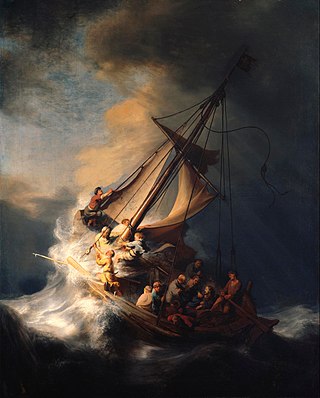
Christ in the Storm on the Sea of Galilee is a 1633 oil-on-canvas painting by the Dutch Golden Age painter Rembrandt van Rijn. It was previously in the Isabella Stewart Gardner Museum in Boston but was stolen in 1990 and remains missing. The painting depicts the biblical story of Jesus calming the storm on the Sea of Galilee, specifically as it is described in the fourth chapter of the Gospel of Mark. It is Rembrandt's only seascape.

Aristotle with a Bust of Homer, also known as Aristotle Contemplating a Bust of Homer, is an oil-on-canvas painting by Rembrandt that depicts Aristotle wearing a gold chain and contemplating a sculpted bust of Homer. It was created as a commission for Don Antonio Ruffo's collection. It was bought and sold by several collectors until it was eventually purchased by the Metropolitan Museum of Art. The mysterious tone in the painting has led several scholars to different interpretations of Rembrandt's theme.

Self Portrait is an oil-on-canvas painting by the Dutch artist Rembrandt. Painted in 1652, it is one of more than 40 painted self-portraits by Rembrandt, and was the first he had painted since 1645. In composition it is different from his previous self-portraits, depicting the painter in a direct frontal pose, hands on his hips, and with an air of self-confidence. It was painted the year that his financial difficulties began, and breaks with the sumptuous finery he had worn in previous self-portraits. Art historian Christopher White has called it "one of the most magisterial and sombre of these (late) pictures". It is in the Kunsthistorisches Museum in Vienna.

The Hundred Guilder Print is an etching by Rembrandt. The etching's popular name derives from the large sum of money supposedly once paid for an example. It is also called Christ healing the sick, Christ with the Sick around Him, Receiving Little Children, or Christ preaching, since the print depicts multiple events from Matthew 19 in the New Testament, including Christ healing the sick, debating with scholars and calling on children to come to him. The rich young man mentioned in the chapter is leaving through the gateway on the right.

Self-Portrait is a 1660 oil on canvas painting by the Dutch artist Rembrandt, one of over 40 self-portraits by Rembrandt. Painted when the artist was fifty-four, it has been noted as a work in which may be seen "the wrinkled brow and the worried expression the troubled condition of his mind". Part of the Benjamin Altman Collection, it has been in the Metropolitan Museum of Art since 1913.
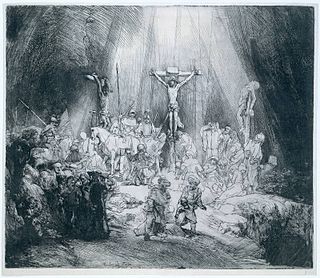
The Three Crosses is a 1653 print in etching and drypoint by the Dutch artist Rembrandt van Rijn, which depicts the crucifixion of Jesus Christ. Most of his prints are mainly in etching and this one is a drypoint with burin adjustments from the third state onwards. It is considered "one of the most dynamic prints ever made".

Flora or Saskia as Flora is a 1634 oil-on-canvas painting by Rembrandt, depicting his wife Saskia van Uylenburgh as the goddess Flora. It is held by the Hermitage Museum in St. Petersburg.

The Goldweigher's Field is a 1651 etching by Rembrandt now held by many museums, including the British Museum, the Rijksmuseum, and the Metropolitan Museum of Art. It is based on a landscape drawing in the collection of the Museum Boijmans van Beuningen.

Portrait of a Woman, probably a Member of the Van Beresteyn Family is a 1632 oil-on-canvas portrait painting by Rembrandt. A depiction of a woman with an unusually large millstone collar, it is a pendant to Portrait of a Man, probably a Member of the Van Beresteyn Family. Both portraits are in the collection of the Metropolitan Museum of Art.

Portrait of a Man, probably a Member of the Van Beresteyn Family is an oil-on-canvas 1632 portrait painting by Rembrandt. It shows a man with a lace collar, which was a new fashion in the 1630s replacing older-styled millstone collars. It is pendant to Portrait of a Woman, probably a Member of the Van Beresteyn Family, and both are in the collection of the Metropolitan Museum of Art.

Oval Portrait of a Woman is a 1633 portrait painting painted by Rembrandt. It shows a woman with a millstone collar and diadem cap. It is in the collection of the Metropolitan Museum of Art.

Portrait of a Man is a c. 1657 portrait painting painted by Rembrandt. It is an oil on canvas and is in the collection of the Metropolitan Museum of Art.
Egbert Haverkamp-BegemannOON was a Dutch American art historian and professor.
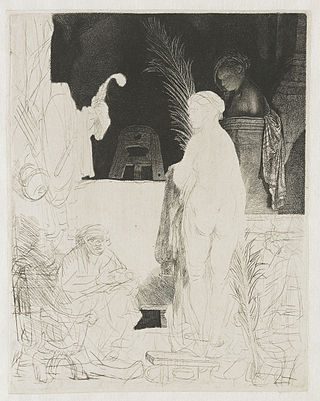
The Artist and his Model is a print by Rembrandt, known in two states, both incomplete. Copies of the work are in the British Museum, the Rijksmuseum, the Mikkel Museum, the Saint Louis Art Museum and many other collections. It was numbered B. 1921 by.
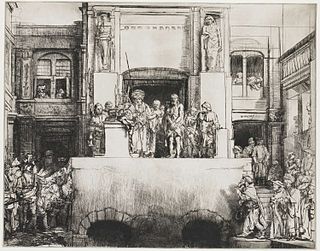
Christ Presented to the People, also known as Ostentatio Christi or Ecce Homo, is a drypoint print by Rembrandt van Rijn which exists in eight states, all c.1655. It is one of the two largest prints made by Rembrandt, about 15 by 18 inches, similar to his 1653 engraving of The Three Crosses. It has been described by Christie's as "at the summit of the western printmaking tradition".

Christ with a Staff or St James the Less is a painting by a follower of Rembrandt, now in the Metropolitan Museum of Art. It was also known as Christ in 1854 and exhibited in 1933 as The Pilgrim.
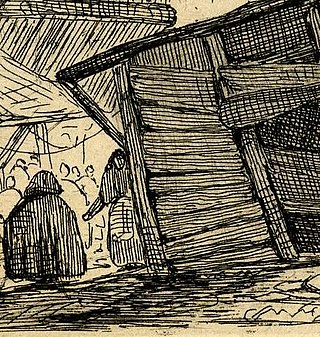
In printmaking, surface tone, or surface-tone, is produced by deliberately or accidentally not wiping all the ink off the surface of the printing plate, so that parts of the image have a light tone from the film of ink left. Tone in printmaking meaning areas of continuous colour, as opposed to the linear marks made by an engraved or drawn line. The technique can be used with all the intaglio printmaking techniques, of which the most important are engraving, etching, drypoint, mezzotint and aquatint. It requires individual attention on the press before each impression is printed, and is mostly used by artists who print their own plates, such as Rembrandt, "the first master of this art", who made great use of it.